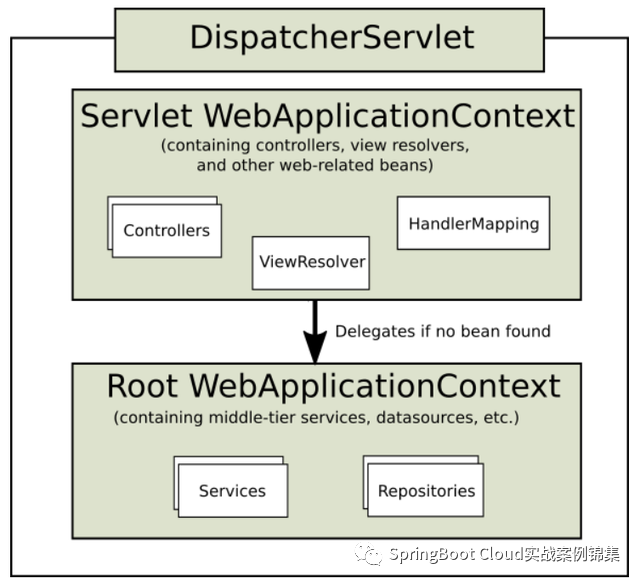环境:Spring5.3.26
SpringMVC使用相信大家都会使用,别人项目工程搭建后,你只需负责写Controller即可,那你是否想过自己能否把环境搭建出来呢?而且还不借助网络;本篇教大家如何通过注解快速搭建SpringMVC运行环境。
传统SpringMVC配置
本节:回顾传统SpringMVC的基本配置原理。
DispatcherServlet需要一个WebApplicationContext(一个普通ApplicationContext的扩展)用于它自己的配置。WebApplicationContext有一个链接到ServletContext和它所关联的Servlet。它还绑定到ServletContext,这样应用程序就可以在需要访问WebApplicationContext时使用RequestContextUtils上的静态方法来查找它。
对于许多应用程序来说,只有一个WebApplicationContext就足够简单了。也可以有一个上下文层次结构,其中一个根WebApplicationContext在多个DispatcherServlet(或其他Servlet)实例之间共享,每个实例都有自己的子WebApplicationContext配置。有关上下文层次结构特性的更多信息,请参阅ApplicationContext的附加功能。
根WebApplicationContext通常包含基础设施bean,例如需要跨多个Servlet实例共享的数据存储库和业务服务。这些bean被有效地继承,并且可以在特定于Servlet的子WebApplicationContext中被重写(即重新声明),该子WebApplicationContext通常包含给定Servlet的本地bean。下图显示了这种关系:

web.xml中配置:
<web-app>
<listener>
<listener-class>org.springframework.web.context.ContextLoaderListener</listener-class>
</listener>
<context-param>
<param-name>contextConfigLocation</param-name>
<param-value>/WEB-INF/root-context.xml</param-value>
</context-param>
<servlet>
<servlet-name>app1</servlet-name>
<servlet-class>org.springframework.web.servlet.DispatcherServlet</servlet-class>
<init-param>
<param-name>contextConfigLocation</param-name>
<param-value>/WEB-INF/app1-context.xml</param-value>
</init-param>
<load-on-startup>1</load-on-startup>
</servlet>
<servlet-mapping>
<servlet-name>app1</servlet-name>
<url-pattern>/app1/*</url-pattern>
</servlet-mapping>
</web-app>ContextLoaderListener:该监听器用来创建Root 容器,该容器就是用来配置基础的Bean,如DAO,Service等。
DispatcherServlet:对应一个web 容器,也就是子容器。该容器用来配置Controller。在Controller中会应用到Service,那么该子容器就会从父容器中查找相应的Bean。如下父子关系配置:
public abstract class FrameworkServlet extends HttpServletBean implements ApplicationContextAware {
protected WebApplicationContext initWebApplicationContext() {
// 获取父容器,该父容器是在ContextLoaderListener监听器中创建并保存到ServletContext中
WebApplicationContext rootContext = WebApplicationContextUtils.getWebApplicationContext(getServletContext());
WebApplicationContext wac = null;
if (this.webApplicationContext != null) {
wac = this.webApplicationContext;
if (wac instanceof ConfigurableWebApplicationContext) {
ConfigurableWebApplicationContext cwac = (ConfigurableWebApplicationContext) wac;
if (!cwac.isActive()) {
if (cwac.getParent() == null) {
cwac.setParent(rootContext);
}
configureAndRefreshWebApplicationContext(cwac);
}
}
}
if (wac == null) {
// 创建子容器并设置父容器
wac = createWebApplicationContext(rootContext);
}
return wac;
}
}以上就是SpringMVC的基本配置。
Servlet注册
既然是基于注解的方式配置SpringMVC,那么我们需要先了解Servlet的注册方式有哪些。
方式1:
web.xml中注册
<servlet>
<servlet-name>DemoServlet</servlet-name>
<servlet-class>com.pack.servlet.DemoServlet</servlet-class>
</servlet>
<servlet-mapping>
<servlet-name>DemoServlet</servlet-name>
<url-pattern>/demo</url-pattern>
</servlet-mapping>方式2:
基于注解方式
@WebServlet(name = "demoServlet", urlPatterns = "/demo")
@WebServlet(value = {"/demo","/demo1"})
@WebServlet(value = "/demo")
@WebServlet("/demo")
public class DemoServlet extends HttpServlet {
// ...
}方式3:
通过SPI技术,这也是今天要使用的方式
Servlet3.0以上的版本开始,可以通过SPI方式注册Servlet,Filter,Listener三大组件。
第一步:在项目中建立如下文件
META-INF/service/javax.servlet.ServletContainerInitializer文件名:javax.servlet.ServletContainerInitializer
第二步:自定义类实现ServletContainerInitializer
@HandlesTypes({CustomHandler.class})
public class CustomContainerInitializer implements ServletContainerInitializer {
// 这里的set集合就是当前环境中所有CustomHandler的子类
@Override
public void onStartup(Set<Class<?>> set, ServletContext servletContext) throws ServletException {
if (set!=null&&set.size()>0){
set.stream().forEach(cls->{
try {
CustomHandler o = (CustomHandler)cls.newInstance();
o.onStartup();
} catch (Exception e) {
e.printStackTrace();
}
});
}
//注入Servlet
ServletRegistration.Dynamic userServlet = servletContext.addServlet("DemoServlet", DemoServlet.class);
userServlet.addMapping("/demo");
}
}SpringMVC注解配置
接下来就是要使用上面介绍的Servlet注册方式的第三种方式来实现SpringMVC的注册。
在Spring中已经提供了相应的实现:
在spring-web包中:

内容:
org.springframework.web.SpringServletContainerInitializer@HandlesTypes(WebApplicationInitializer.class)
public class SpringServletContainerInitializer implements ServletContainerInitializer {
}这里我们只需要实现WebApplicationInitializer接口即可,不过Spring已经为我们定义好了该接口的抽象模版,我们只需继承该抽象类即可:
public class SpringMVCConfig extends AbstractAnnotationConfigDispatcherServletInitializer {
@Override
protected Class<?>[] getRootConfigClasses() {
return new Class<?>[] {RootConfig.class} ;
}
@Override
protected Class<?>[] getServletConfigClasses() {
return new Class<?>[] {WebConfig.class} ;
}
@Override
protected String[] getServletMappings() {
return new String[] {"/"} ;
}
}RootConfig.java
@Configuration
public class RootConfig {
}WebConfig.java
@Configuration
@ComponentScan(basePackages = {"com.pack.controller"})
public class WebConfig {
}测试controller
@RestController
@RequestMapping("/demo")
public class DemoController {
@GetMapping("")
public Object index() {
Map<String, Object> result = new HashMap<>() ;
result.put("code", 0) ;
result.put("data", "你好") ;
return result ;
}
}测试:
只是通过如上配置,SpringMVC环境基本上是可以使用了,但是我们看上面Controller接口,是基于REST full,所以当你访问该接口时会出现如下错误:

这是因为默认情况下RequestMappingHandlerAdapter无法处理,服务器端无法提供与 Accept-Charset 以及 Accept-Language 消息头指定的值相匹配的响应。
这时候就需要为其配置相应的消息转换器:
@Bean
public RequestMappingHandlerAdapter requestMappingHandlerAdapter() {
RequestMappingHandlerAdapter adapter = new RequestMappingHandlerAdapter() ;
adapter.getMessageConverters().add(new MappingJackson2HttpMessageConverter()) ;
return adapter ;
}再次方法正常:

完毕!!!































